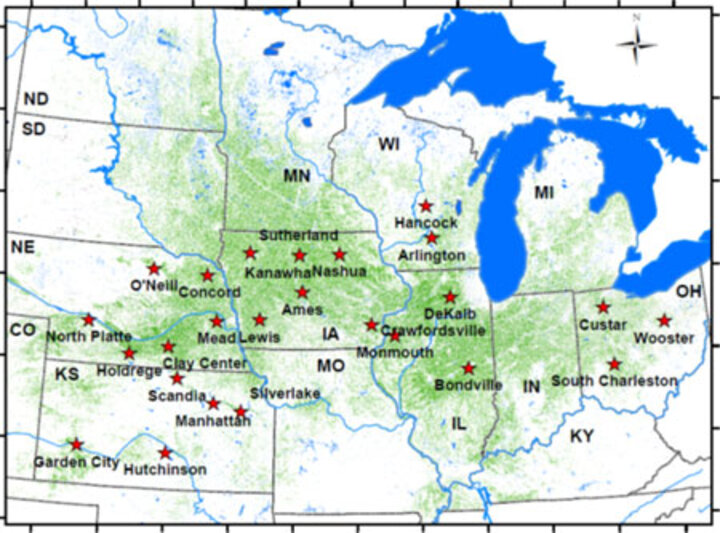
Oct. Yield Forecasts
Western Corn Belt (Table 2)
Central/Eastern Corn Belt (Table 3)
Simulating Corn Yield Potential with Hybrid-Maize Model
Oct. 24, 2014The Hybrid-Maize model (http://hybridmaize.unl.edu) simulates daily corn growth and development and final grain yield under irrigated and dryland conditions. The model estimates "yield potential," which is the yield obtained when the crop is not limited by nutrient supply, diseases, insect pressure, or weed competition conditions that represent an "optimal management" scenario. It also assumes a uniform plant stand at the specified plant population, and no problems from flooding or hail.
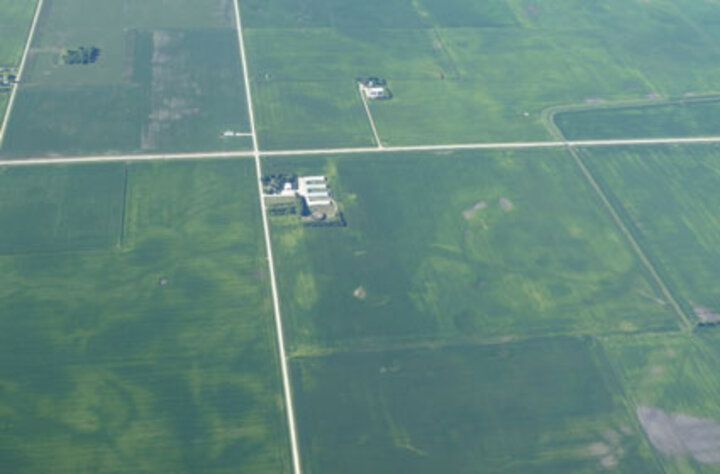
Figure 3. Aerial image of north-central Iowa fields on July 16, 2014. (Photo courtesy of Peter Scharf, University of Missouri)

Figure 5. Green-snap occurring on V6-V8 stage corn in south central Nebraska after June 14 wind storm. Some producers slotted in a short-season corn hybrid in worst affected areas. (Photo by Jenny Rees, UNL)
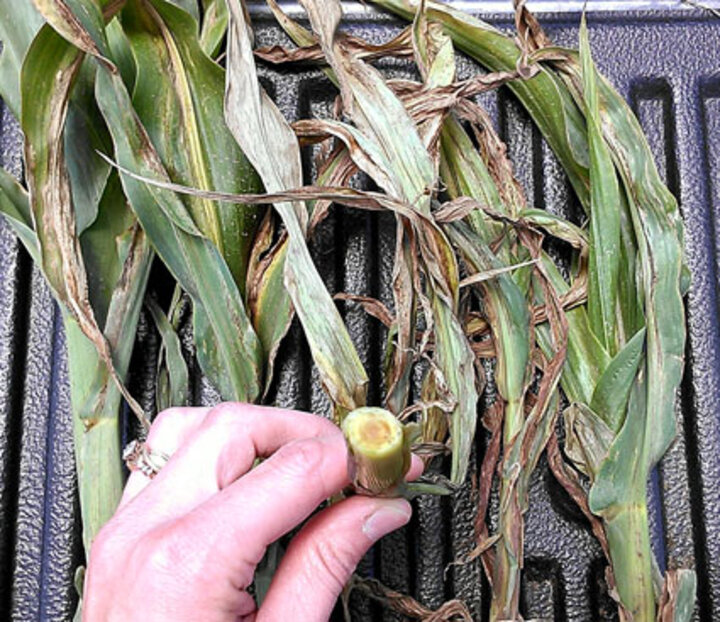
Figure 6. Systemic Goss' wilt damage in corn fields in Clay County June 20, 2014. (Photo by Jenny Rees, UNL)
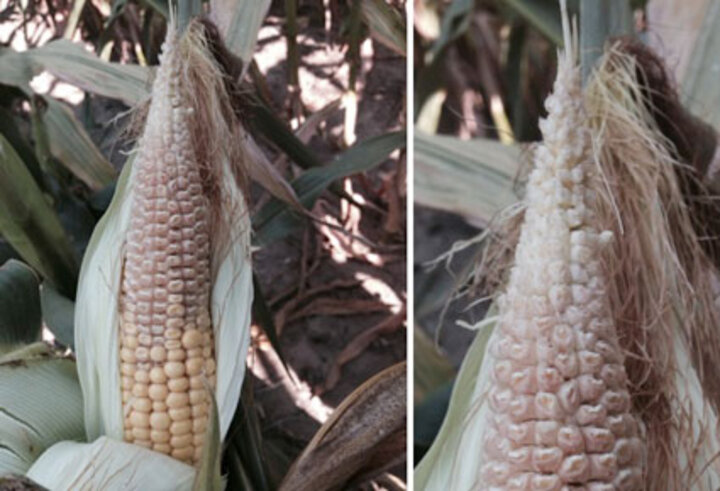
Oct. 24, 2014
Corn grain filling is complete in the Corn Belt and producers are harvesting their fields. During the past months, we have performed bi-weekly forecasts of corn yield potential for 25 locations in the Corn Belt (see Figure 1) to evaluate the impact of this season's weather on corn yield potential, and its spatial variability. Hybrid-Maize simulations were based on actual weather data and typical management practices at the location being simulated as provided by extension educators in each state (see Table 1).
In this article, we present the final 2014 simulated corn yield potential for each of the 25 locations. By comparing the simulated yield potential for 2014 (second column from right in Table 2 and Table 3) to the long-term average yield potential (third column in Table 2 and Table 3), it is possible to indicate if 2014 corn yield potential is below- (10%) (first column from right in Table 2 and Table 3).
A summary of the weather conditions (daily solar radiation, maximum and minimum temperature, total rainfall, and total reference evapotranspiration [ET]) for June 15 – Sept. 15 is presented in Figure 2 to help interpret the simulated yields. In Figure 2, vertical bars indicate the range for these variables based on 20+ years of weather records. The horizontal thick line indicates the long-term average while the red dots indicate the 2014 averages.
Irrigated yield potential was near-average in Nebraska, except for two locations in the south central region (Holdrege and Clay Center) where 2014 simulated yields were 11% to 19% above average. As can be seen in Figure 2, temperatures were below-average at all sites in Nebraska, which led to an extended grain-filling period. However, the positive impact of mild temperatures on yield was offset at most locations by low levels of incident solar radiation due to the high frequency of rainy, cloudy days. In Kansas, simulated irrigated yield was near-average at all sites.
Mild temperatures and high rainfall at most locations across the Corn Belt led to a favorable 2014 growing season for dryland corn. At 14 of the 21 dryland sites, 2014 yield potential was well above the long-term average yield potential due to above-normal rainfall (four sites), below-normal reference ET (three sites), or a combination of both (seven sites). It is noteworthy that in our first 2014 yield forecast on July 20, we anticipated, with a high level of probability, above-average dryland corn at 11 of the 14 locations that ultimately reached above-average dryland yields. At the other seven sites, mostly located in the northern and southern fringes of the Corn Belt (northern Iowa, Wisconsin, and Kansas), simulated yields were near-average due to early incidence of killing frost (northern locations) and near-normal rainfall and reference ET (Kansas).
Expectations for Models and Field Results
So, how do we expect producer yields to compare with Hybrid-Maize simulations? In terms of absolute yield, we expect most producers to be below the simulated yield potential because model simulations assume optimum crop management. Despite this, in well-managed, timely planted fields, with even crop stands that were not damaged by hail, flooding, diseases, weeds, and insect pests, past experience indicates that producer yields follow the trend in simulated yields (i.e., to be below, near or above past years' yields). Late-season nitrogen deficiency due to excessive rainfall is one reason why 2014 producer yields may be consistently below simulated yields, even in well-managed fields. For example, N deficiency may have affected 15-30% of the corn fields in Iowa and Illinois, with first symptoms of N deficiency observed in mid-July (Figure 3). This effect may occur to a lesser extent in Nebraska with N deficiency symptoms appearing over 10% of the corn fields in northeast Nebraska.
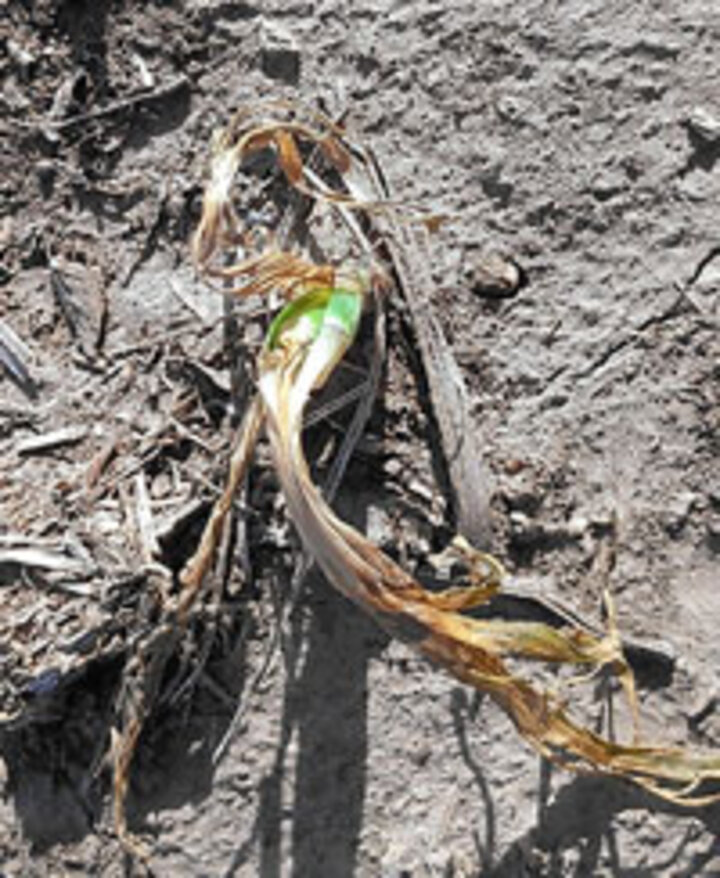
Figure 4. Corn affected by low temperatures caused by frost damage in Clay County May 15, 2014. (Photo by Jenny Rees, UNL)
In fields with poor establishment, or affected by hail or flooding, as well as in replanted fields (as is the case in many fields in south central and eastern Nebraska this year, see Figures 4-5), we expect Hybrid-Maize yield simulations to be considerably higher than actual yields from such fields. Likewise, high disease or pest pressure may have negatively impacted producer yields, although their overall regional impact is unknown. For example, in south central Nebraska, early wounding from tornadoes, wind, frost, and/or hail promoted early season systemic Goss' wilt in fields with a previous history of this disease (Figure 6). Likewise, incidence of northern corn leaf blight and Goss's Wilt was reported in western Iowa fields starting in early August. Finally, producer dryland yields in Kansas might fall below simulated yield in fields where crops suffered large kernel abortion due to severe heat and water stress during pollination (Figure 7).
Despite these problems in some areas, we can expect that average yields in the Corn Belt will be well above average.
Patricio Grassini, UNL Assistant Professor of Agronomy and Horticulture, Extension Cropping System Specialist and Robert B. Daugherty Water for Food Institute Fellow
Francisco Morell, UNL Post Doctoral Research Associate
Haishun Yang, UNL Associate Professor of Agronomy and Horticulture and Robert B. Daugherty Water for Food Institute Fellow
Roger Elmore, UNL Professor of Agronomy and Horticulture, Extension Cropping System Specialist and Robert B. Daugherty Water for Food Institute Fellow
Ken Cassman, UNL Professor of Agronomy and Horticulture and Robert B. Daugherty Water for Food Institute Fellow
Jenny Rees, UNL Extension Educator
Charles Shapiro, UNL Extension Soils Specialist and Professor of Agronomy and Horticulture
Keith Glewen, UNL Extension Educator
Greg Kruger, UNL Assistant Professor of Agronomy and Horticulture and UNL Extension Cropping System Specialist
Mark Licht, Extension Cropping System Agronomist, Iowa State University
Ignacio Ciampitti, Crop Production and Cropping System Specialist and Assistant Professor of Agronomy, Kansas State University
Peter Thomison, Extension Specialist and Professor, Ohio State University
Joe Lauer, Professor, University of Wisconsin-Madison
